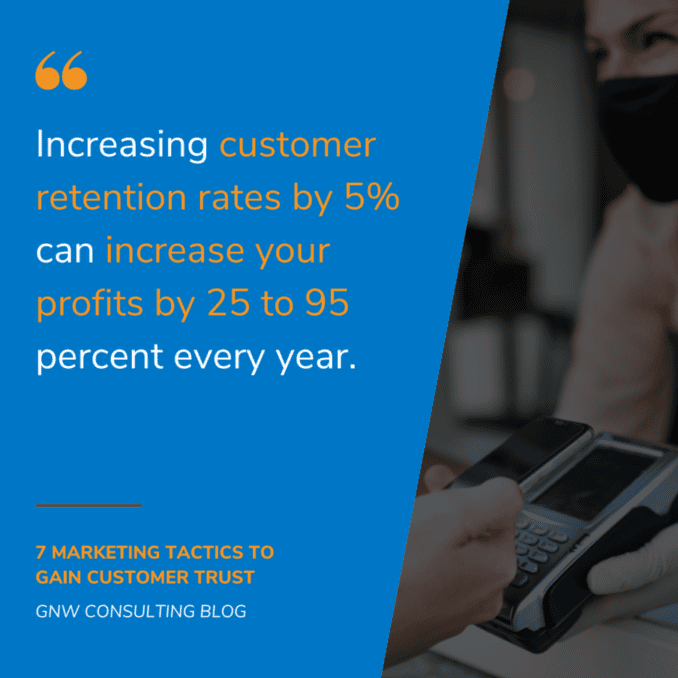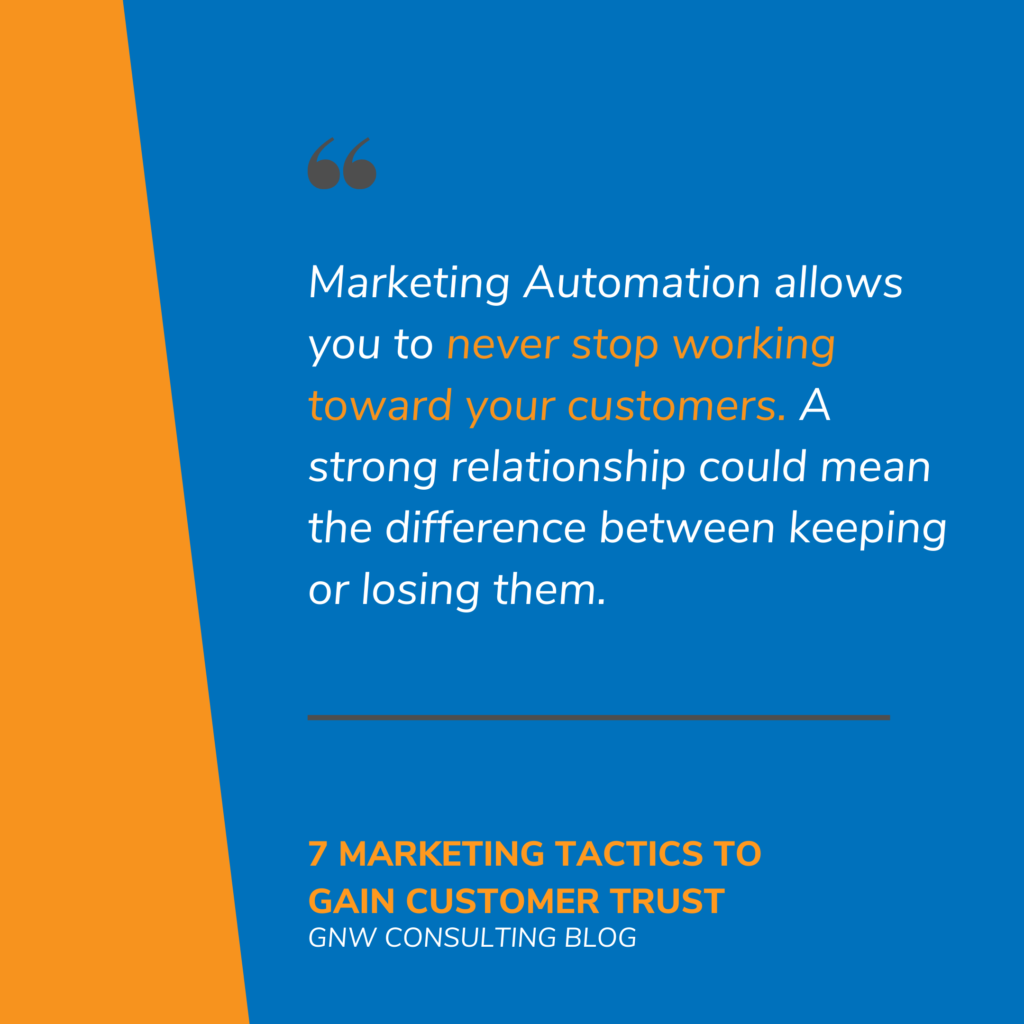
Customer trust has never been more important for marketers to set as a goal. While companies focus on revenue drivers, building brand loyalty is important for long-term strategic marketing. It is essential for the longevity of any business. Holistic marketing strategies put customer satisfaction at the center and while attaining customer happiness can sound like a lofty goal, it is possible to focus on the customer service to ensure you can deliver on your promises as a brand. According to research by Bain and Company, increasing customer retention rates by 5% increases profits by 25 to 95 percent, so here are some steps to help you build trust with your customers.
1. Don’t Hide Your Faults, Be Transparent
This is one of the most difficult parts of gaining trust and it starts with lead generation. There are many stories of data breaches and companies misusing customer data for their benefit, so it is essential for you to disclose how you’re using all the personal information you collect. To transparently and responsibly collect data consider starting here:
- Speak in plain language and don’t use jargon. Be very clear on how and where the data you collect is going to be used before you ask for it.
- Provide value. Companies shouldn’t be the only ones benefiting from collecting customer data. Offer something of real value in return for that email such as a discount or loyalty account. Ensure the tradeoff is mutually beneficial for you both or don’t ask for the data at all.
- Spell it out. Don’t simply ask for their location if you’re not delivering personalized content. Let them know why you need to know sensitive information like addresses, phone numbers and zip codes.
- Safeguard Data. Invest in a secure system that includes malware, antivirus and firewalls. The system you build protects your customer’s data, so pick the best option for your business and don’t forget to back everything up.
- Keep a clean house. When it comes to data, don’t just focus on quantity. Scrub your data and do it often. Ensure that all data points are up-to-date. This won’t just improve productivity and make your campaigns more effective, but it could save your business from confusion and redundancy
- Know your boundaries and regulations. There are rules that need to be followed across the world, so if you have doubts about it, air on the safe side. Be cognizant of how frequently you use customer information to market to them. You don’t want to cross a boundary with a customer.
Consumers expect personalized service but are wary of giving away their personal data, so remember to be responsible and transparent about how you handle their precious information.
2. Don’t Force Your Brand to Fit an Agenda
The word “authenticity” gets thrown around a lot in marketing, but for a good reason. Being authentic means our words and actions are congruent with our beliefs and values. Don’t simply force your brand to fit an agenda, be real. All good companies have a core set of values that define their culture, so sharing those values internally and externally inspires loyalty and engagement. When a company operates on the pretense that its customers are at the center of everything they do and truly displays that, you’re on the path to becoming a brand customers love and trust.

Authenticity doesn’t just drive revenue, it builds stronger connections and resonates deeply with your audience. Think of brands like Patagonia or Dove who provide customers with in-depth information about their brand and how they give back. These are great examples of the power of authentic brands, but be sure to remember you don’t have to be perfect to thrive, just be honest.
3. Be ‘People Before Profit’ Focused
Being beneficial starts by crafting measurable and impactful marketing campaigns. When your brand’s identity is focused on benefiting your customers, you’ll have no trouble creating marketing campaigns that resonate and build brand loyalty. However, there are some essentials you should look at when creating your next ‘people first’ campaign:
- Ensure your strategy is clear and realistic. Don’t set up expectations your brand can’t meet, focus on what you can do to help your customers.
- Target the right audience. You can’t provide benefits to someone you don’t know. Take time to figure out who your customer is and what they need the most.
- Be highly engaging. When trying to deliver real value, you need to focus on creating content that your audience can authentically engage with.
- Make the process easy. If you’re asking a customer to purchase, don’t make it difficult. The experience is part of the process, so make sure that your landing pages, content, and email templates are all exceptional. When you can make your buying process enjoyable, your customers will feel comfortable and it might even entice them to buy again.
- Define outcomes. Be focused on your goals, don’t divert for the sake of diversion. If you’re not seeing results, be patient, and optimize as needed. Be sure you consider your customer’s outcomes too, not just your business goals.
While each business has different obstacles, you can easily map out a campaign that is beneficial to your customer base. Be sure to think about how your product helps the end-user overcome challenges and lean into that as your overall brand messaging evolves.
4. Focus on Empathy and Prioritize It

Speaking of honesty, it usually comes hand in hand with enacting empathy. As previously mentioned, customers are at the core of your business, so treat them like gold. Empathy is all about understanding the needs and feelings of another, so focus on the 3 types of empathy as they relate to your business:
- Cognitive Empathy: Be able to put yourself in your customer’s shoes. What is their current perspective of your business or product? Are you considering their needs when building a new campaign or improving your service?
- Emotional Empathy: This can often be difficult for businesses as it literally means feeling another person’s emotions. However, it isn’t impossible. When creating campaigns, focus on the emotions they elicit. You can also leverage emotional empathy to determine your response to major events that may impact your brand. Always be willing to help your customers feel heard.
- Compassionate Empathy: Many brands fall short when it comes to compassionate empathy. Offering help to customers can come in many forms. From informing your customer service team to ensuring sales understands the immediate problems faced by your customers, you’ll need to train every employee to treat each customer as an individual.
5. Anticipate Customer Needs
Sometimes it isn’t enough to know your customer’s current challenges. You have to be prepared to deliver exceptional customer experience and service before your client starts doing business with you. It only takes a moment to lose a customer, so try to focus on their customer journey to ensure you know what’s coming next.
We recommend using your lead lifecycle to better engage prospects. So what does that mean? It means you will want to understand the key stages or moments when you can leverage tools like marketing automation and a CRM to engage prospects. The traditional lead lifecycle model is categorized in stages such as TOFU (top of funnel), MOFU (middle of funnel), and BOFU (bottom of funnel), but taking a look at the Demand Unit Waterfall method may help you improve upon existing business practices and leverage technology such as predictive analytics to anticipate customer needs.
6. Leverage Technology to Deliver Experiences
One of the best ways to set yourself apart from competitors is to deliver a modern user experience. As we mentioned before, delivering top-of-the-line customer service is important, but ensuring that your customers have a unique experience throughout their journey is also part of that. So, how can your brand become an experience-maker? Here are 3 simple ways to do it:
- Rethink your customer experiences: this goes back to showing empathy for your customers. You need to care about and create an action plan to respond to customer problems immediately. Learn to leverage marketing automation and other tools to address customer needs on a dime. If you need help implementing these tools, consider working with our strategic marketing consultants to help you evaluate what your business needs.
- Adapt and embrace: Don’t get stuck in your old ways of doing things simply because it is easier or more profitable. Digital transformation is upon us and if you’re still benefiting from resisting it now, you won’t for long. Companies and leaders who focus on digital-first experiences have the ability to pivot and evolve no matter what challenges come their way. Think of COVID-19, only brands who adapted digital processes and remote work early on continued business as usual. Those who didn’t are still playing catch-up and feeling the impact of extraneous circumstances. Don’t forget that transforming your business can be felt by your customers, so delivering a new experience can help delight them for the long haul.
- Be diverse, yet inclusive: If you only follow one trend in 2020, it should be this one. Audience segmentation and targeting are at the core of successful marketing strategies, but can often lead to exclusion. Take a look at the current systems in place through the lens of diversity and inclusion. Are you making sure all your customers, employees and partners are being heard? Take a step back and set high standards for your brand to be more inclusive. This means that businesses must be incrementally self-aware about the impact their brands have on society and their customers. Don’t forget that customer trust and marketing authenticity are reliant on diversity and inclusion.
7. Invest in Marketing Automation

There’s no excuse to not invest in automation. It increases sales, allows for improved lead nurturing, but most importantly it is the best way to increase customer retention. Automation allows you to never stop working toward your customers. A strong relationship could mean the difference between keeping or losing them. Prioritize automation and hire experts to ensure you’re creating the best experience possible. Be sure you’re implementing:
- Keep it Personalized: Ensuring your messages are relevant is the most important thing to consider when leveraging automation. Map your customer journey and consider different triggers you can build upon to alleviate customer pain points.
- Eliminate Tedious Tasks: Take a look at all your existing processes. Is your sales team struggling with overwhelming data entry and administrative tasks? Automate your sales cycle and make it easier for them to focus on the client, not the task.
- Bring it All Together: It’s important to ensure all your teams are integrated and tuned into the automation process. Keep communication channels open and establish relationships across departments. If your team needs support, hire an expert to provide in-depth training of new tools, implement effective processes and help you find the automation platform that integrates best with your existing platforms.
Final Thoughts
Gaining customer trust isn’t easy, but we know that you’ll find plenty of value from leveraging these tactics. Ensuring the happiness of your customers translates to business success for the long haul. If you’re looking for ways to ensure client happiness, our consultants can help you map out what is best for your customers at every stage of their journey.